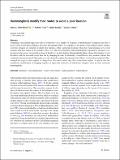Files in this item
Hummingbirds modify their routes to avoid a poor location
Item metadata
| dc.contributor.author | Tello-Ramos, Maria C. | |
| dc.contributor.author | Hurly, T. Andrew | |
| dc.contributor.author | Barclay, Mabel | |
| dc.contributor.author | Healy, Susan D. | |
| dc.date.accessioned | 2021-08-03T08:30:06Z | |
| dc.date.available | 2021-08-03T08:30:06Z | |
| dc.date.issued | 2021-08-02 | |
| dc.identifier | 275130279 | |
| dc.identifier | 55a0d87e-ceb4-41ce-b3be-c553d755bcb9 | |
| dc.identifier | 85111833269 | |
| dc.identifier | 000680362300001 | |
| dc.identifier.citation | Tello-Ramos , M C , Hurly , T A , Barclay , M & Healy , S D 2021 , ' Hummingbirds modify their routes to avoid a poor location ' , Learning and Behavior , vol. First Online . https://doi.org/10.3758/s13420-021-00476-3 | en |
| dc.identifier.issn | 1543-4494 | |
| dc.identifier.other | ORCID: /0000-0002-8059-4480/work/98196621 | |
| dc.identifier.uri | https://hdl.handle.net/10023/23702 | |
| dc.description.abstract | Traplining, when animals repeat the order in which they visit a number of locations, is taxonomically widespread, but little is known about which factors influence the routes that animals follow. For example, as the quality of rewarding locations changes over time, foragers are expected to update their traplines, either to prioritize locations where the reward increases or to avoid locations that have ceased to be profitable. Here, we tested how traplining wild hummingbirds responded to increases or to decreases in the sucrose concentration of one of the flowers on their trapline. Hummingbirds did not change their trapline to visit the flower with the increased reward first, but by changing the order in which they visited flowers, they avoided a flower that contained a decreased reward. Depending on where along the trapline the reduced-content flower occurred, hummingbirds either changed the origin of their trapline or changed the direction in which they flew around their trapline. It may be that this asymmetric modification of foraging traplines is especially noticeable in risk-averse foragers, such as these territorial hummingbirds. | |
| dc.format.extent | 10 | |
| dc.format.extent | 618123 | |
| dc.language.iso | eng | |
| dc.relation.ispartof | Learning and Behavior | en |
| dc.subject | Traplining | en |
| dc.subject | Route optimization | en |
| dc.subject | Recursive movements | en |
| dc.subject | Spatial cognition | en |
| dc.subject | Hummingbirds | en |
| dc.subject | QH301 Biology | en |
| dc.subject | DAS | en |
| dc.subject.lcc | QH301 | en |
| dc.title | Hummingbirds modify their routes to avoid a poor location | en |
| dc.type | Journal article | en |
| dc.contributor.institution | University of St Andrews. School of Biology | en |
| dc.contributor.institution | University of St Andrews. Centre for Biological Diversity | en |
| dc.contributor.institution | University of St Andrews. Centre for Social Learning & Cognitive Evolution | en |
| dc.contributor.institution | University of St Andrews. Institute of Behavioural and Neural Sciences | en |
| dc.identifier.doi | 10.3758/s13420-021-00476-3 | |
| dc.description.status | Peer reviewed | en |
| dc.identifier.url | https://link.springer.com/article/10.3758%2Fs13420-021-00476-3#Sec13 | en |
This item appears in the following Collection(s)
Items in the St Andrews Research Repository are protected by copyright, with all rights reserved, unless otherwise indicated.

